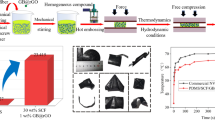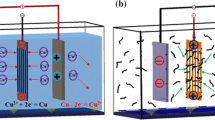Abstract
Traditional compounding method is a common way to construct network to improve thermal conductivity (TC) of polymeric composites. However, the TC of the composites increases slowly when the network has been constructed. There is no percolation threshold in TC, unlike in electrical conductivity. Thus, a method of spatial confining forced network assembly (SCFNA) was used to prepare polydimethylsiloxane (PDMS)/short carbon fiber (SCF) composites to improve the TC. The content of SCF ranging from 2 to 18 wt% was used to illustrate availability of SCFNA method. When the content of SCF was 18 wt%, the TC of PDMS/SCF composites prepared by SCFNA method increased by 7.79 times over the TC of PDMS/SCF composites prepared by traditional compounding method and 10.93 times over the TC of pure PDMS. Comparing the SEM of PDMS/SCF composites prepared by SCFNA method with that prepared by traditional compounding method, the gap between fillers of former was much smaller than that of latter. Moreover, the gap decreased when compression ratio increased. Therefore, the TC of composites prepared by SCFNA method could be improved significantly compared with traditional methods, which provides the possibility to replace thermally conductive materials such as metal with polymeric composites.











Similar content being viewed by others
Change history
09 April 2019
The definition of in Eq. (1) (page 14301) is the average thermal resistance should be written as is the average thermal distance.
09 April 2019
The definition of in Eq. (1) (page 14301) is the average thermal resistance should be written as is the average thermal distance.
References
Kashfipour M, Mehra N, Zhu J (2018) A review on the role of interface in mechanical, thermal, and electrical properties of polymer composites. Adv Compos Hybrid Mater. https://doi.org/10.1007/s42114-018-0022-9
Lin J, Chen X, Chen C et al (2018) Durably antibacterial and bacterially antiadhesive cotton fabrics coated by cationic fluorinated polymers. ACS Appl Mater Interfaces 10:6124–6136
Hu Z, Shao Q, Huang Y et al (2018) Light triggered interfacial damage self-healing of poly(p-phenylene benzobisoxazole) fiber composites. Nanotechnology. https://doi.org/10.1088/1361-6528/aab010
Li Y, Zhou B, Zheng G et al (2018) Continuously prepared highly conductive and stretchable SWNT/MWNT synergistically composited electrospun thermoplastic polyurethane yarns for wearable sensing. J Mater Chem C 6:2258–2269
Sun K, Fan R, Zhang X et al (2018) An overview of metamaterials and their achievements in wireless power transfer. J Mater Chem C 6:2925–2943
Hu Z, Shao Q, Xu X, Zhang D, Huang Y (2017) Surface initiated grafting of polymer chains on carbon nanotubes via one-step cycloaddition of diarylcarbene. Compos Sci Technol 142:294–301
He Y, Yang S, Liu H et al (2018) Reinforced carbon fiber laminates with oriented carbon nanotube epoxy nanocomposites: magnetic field assisted alignment and cryogenic temperature mechanical properties. J Colloid Interf Sci 517:40–51
Wang X, Liu X, Yuan H et al (2018) Non-covalently functionalized graphene strengthened poly(vinyl alcohol). Mater Design 139:372–379
Gu J, Dong W, Tang Y et al (2017) Ultralow dielectric, fluoride-containing cyanate ester resins with improved mechanical properties and high thermal and dimensional stabilities. J Mater Chem C 5:6929–6936
Sha L, Chen Z, Chen Z, Zhang A, Yang Z (2016) Polylactic acid based nanocomposites: promising safe and biodegradable materials in biomedical field. Int J Polym Sci. https://doi.org/10.1155/2016/6869154
Chen Z, Zhang A, Yang Z, Wang X, Chang L, Chen Z, Lee L (2016) Application of DODMA and derivatives in cationic nanocarriers for gene delivery. Curr Org Chem 20:1813–1819
Xie J, Teng L, Yang Z, Zhou C, Liu Y, Yung B, Lee R (2013) A polyethylenimine-linoleic acid conjugate for antisense oligonucleotide delivery. Biomed Res Int. https://doi.org/10.1155/2013/710502
Ngo IL, Jeon S, Byon C (2016) Thermal conductivity of transparent and flexible polymers containing fillers: a literature review. Int J Heat Mass Tran 98:219–226
Guo Y, Xu G, Yang X et al (2018) Significantly enhanced and precisely modeled thermal conductivity in polyimide nanocomposites with chemically modified graphene via in situ polymerization and electrospinning-hot press technology. J Mater Chem C 6:3004–3015
Zhong S, Zhou Z, Zhang K et al (2016) Formation of thermally conductive networks in isotactic polypropylene/hexagonal boron nitride composites via “Bridge Effect” of multi-wall carbon nanotubes and graphene nanoplatelets. RSC Adv 6:98571–98580
Zhu Z, Wang P, Lv P et al (2017) Densely packed polymer/boron nitride composite for superior anisotropic thermal conductivity. Polym Compos. https://doi.org/10.1002/pc.24615
Feng C, Bai L, Bao R, Liu Z, Yang M, Chen J, Yang W (2018) Electrically insulating POE/BN elastomeric composites with high through-plane thermal conductivity fabricated by two-roll milling and hot compression. Adv Compos Hybrid Mater 1:160–167
Dang TML, Kim CY, Zhang Y, Yang J, Masaki T, Yoon D (2017) Enhanced thermal conductivity of polymer composites via hybrid fillers of anisotropic aluminum nitride whiskers and isotropic spheres. Compos Part B-Eng 114:237–246
Yu GC, Wu LZ, Feng LJ, Yang W (2016) Thermal and mechanical properties of carbon fiber polymer-matrix composites with a 3D thermal conductive pathway. Compos Struct 149:213–219
Tian B, Yang W, Luo L et al (2016) Synergistic enhancement of thermal conductivity for expanded graphite and carbon fiber in paraffin/EVA form-stable phase change materials. Sol Energy 127:48–55
King JA, Via MD, King ME, Miskioglu I, Bogucki GR (2011) Electrical and thermal conductivity and tensile and flexural properties: comparison of carbon black/polycarbonate and carbon nanotube/polycarbonate resins. J Appl Polym Sci 121:2273–2281
Yin B, Wen Y, Jia H, Wang J, Xu Z, Ding L (2017) Synergistic effects of hybridization of carbon black and carbon nanotubes on the mechanical properties and thermal conductivity of a rubber blend system. J Polym Eng 37:785–794
Yoo Y, Lee H, Ha S, Jeon B, Won J, Lee S (2013) Effect of graphite and carbon fiber contents on the morphology and properties of thermally conductive composites based on polyamide 6. Polym Int 63:151–157
Zhou S, Chen Y, Zou H, Liang M (2013) Thermally conductive composites obtained by flake graphite filling immiscible Polyamide 6/Polycarbonate blends. Thermochim Acta 566:84–91
EI-Brolossy T, Ibrahim S, Alkhudhayr E (2015) Carbon nanotube functionalization effects on thermal properties of multiwall carbon nanotube/polycarbonate composites. Polym Compos 36:1242–1248
Kim H, Jang J, Yu J, Kim S (2015) Thermal conductivity of polymer composites based on the length of multi-walled carbon nanotubes. Compos Part B-Eng 79:505–512
Wu Z, Gao S, Chen L et al (2017) Electrically insulated epoxy nanocomposites reinforced with synergistic core-shell SiO2@MWCNTs and montmorillonite bifillers. Macromol Chem Phys. https://doi.org/10.1002/macp.201700357
Chen Z, Zhang A, Wang X, Zhu J, Fan Y, Yu H, Yang Z (2017) The advances of carbon nanotubes in cancer diagnostics and therapeutics. J Nanomater. https://doi.org/10.1155/2017/3418932
Kim H, Bae H, Yu J, Kim S (2016) Thermal conductivity of polymer composites with the geometrical characteristics of graphene nanoplatelets. Sci Rep 6:26825
Tibbetts G, Lake M, Strong K, Rice B (2007) A review of the fabrication and properties of vapor-grown carbon nanofiber/polymer composites. Compos Sci Technol 67:1709–1718
Yin L, Zhou X, Yu J, Wang H, Ran C (2016) Fabrication of a polymer composite with high thermal conductivity based on sintered silicon nitride foam. Compos Part A-Appl S 90:626–632
Huang H, Liu C, Yang W, Fan S (2005) Aligned carbon nanotube composite films for thermal management. Adv Mater 17:1652–1656
Zhao M, Meng L, Ma L et al (2018) Layer-by-layer grafting CNTs onto carbon fibers surface for enhancing the interfacial properties of epoxy resin composites. Compos Sci Technol 154:28–36
Chen L, Hou X, Song N, Shi L, Ding P (2018) Cellulose/graphene bioplastic for thermal management: enhanced isotropic thermally conductive property by three-dimensional interconnected graphene aerogel. Compos Part A Appl S 107:189–196
Hu J, Huang Y, Yao Y et al (2017) Polymer composite with improved thermal conductivity by constructing a hierarchically ordered three-dimensional interconnected network of BN. ACS Appl Mater Interfaces 9:13544–13553
Mazov I, Burmistrov I, Il’Inykh I, Stepashkin A, Kuznetsov D, Issi J (2015) Anisotropic thermal conductivity of polypropylene composites filled with carbon fibers and multiwall carbon nanotubes. Polym Compos 36:1951–1957
Yu A, Ramesh P, Itkis M, Bekyarova E, Haddon R (2007) Graphite nanoplatelet-epoxy composite thermal interface materials. J Phys Chem C 111:7565–7569
Qi L, Guo Y, Li W et al (2014) Ultrahigh thermal conductivity of assembled aligned multilayer graphene/epoxy composite. Chem Mater 26:4459–4465
Huxtable S, Cahill D, Shenogin S et al (2003) Interfacial heat flow in carbon nanotube suspensions. Nat Mater 2:731–734
Nan C, Liu G, Lin Y, Li M (2004) Interface effect on thermal conductivity of carbon nanotube composites. Appl Phys Lett 85:3549–3551
Zhao J, Wu L, Zhang C, Shao Q, Guo Z, Zhang L (2017) Overview of polymer nanocomposites: computer simulation understanding of physical properties. Polymer 133:272–287
Zhou W (2011) Effect of coupling agents on the thermal conductivity of aluminum particle/epoxy resin composites. J Mater Sci 46:3883–3889. https://doi.org/10.1007/s10853-011-5309-y
Muratov D, Kuznetsov D, Il’inykh I, Burmistrov I, Mazov I (2015) Thermal conductivity of polypropylene composites filled with silane-modified hexagonal BN. Compos Sci Technol 111:40–43
Wu D, Gao X, Sun J et al (2017) Spatial confining forced network assembly for preparation of high-performance conductive polymeric composites. Compos Part A-Appl S 102:88–95
Gao X, Huang Y, Liu Y, Kormakov S, Zheng X, Wu D, Wu D (2017) Improved electrical conductivity of PDMS/SCF composite sheets with bolting cloth prepared by a spatial confining forced network assembly method. RSC Adv 7:14761–14768
Sun K, Xie P, Wang Z et al (2017) Flexible polydimethylsiloxane/multi-walled carbon nanotubes membranous metacomposites with negative permittivity. Polymer 125:50–57
Cui X, Zhu G, Pan Y et al (2018) Polydimethylsiloxane-titania nanocomposite coating: fabrication and corrosion resistance. Polymer 138:203–210
Wu D, Sun J, Liu Y, Yang Z, Xu H, Zheng X, Gou P (2017) Rapid fabrication of microstructure on PMMA substrate by the plate to plate Transition-Spanning isothermal hot embossing method nearby glass transition temperature. Polym Eng Sci 57:268–274
Sun J, Wu D, Liu Y, Dai L, Jiang C (2017) Numerical simulation and experimental study of filling process of micro prism by isothermal hot embossing in solid-like state. Adv Polym Technol. https://doi.org/10.1002/adv.21815
Liu H, Huang W, Yang X et al (2016) Organic vapor sensing behaviors of conductive thermoplastic polyurethane–graphene nanocomposites. J Mater Chem C 4:4459–4469
Liu H, Dong M, Huang W et al (2017) Lightweight conductive graphene/thermoplastic polyurethane foams with ultrahigh compressibility for piezoresistive sensing. J Mater Chem C 5:73–83
Hu L, Li Y, Dai K et al (2016) Electrically conductive thermoplastic elastomer nanocomposites at ultralow graphene loading levels for strain sensor applications. J Mater Chem C 4:157–166
Hu C, Li Z, Wang Y (2017) Comparative assessment of the strain-sensing behaviors of polylactic acid nanocomposites: reduced graphene oxide or carbon nanotubes. J Mater Chem C 5:2318–2328
Sun J, Zhuang J, Jiang H, Huang Y, Zheng X, Liu Y, Wu D (2017) Thermal dissipation performance of metal-polymer composite heat exchanger with V-shape microgrooves: a numerical and experimental study. Appl Therm Eng 121:492–500
Zhuang J, Huang C, Zhou G et al (2016) Influence of factors on heat dissipation performance of composite metal–polymer heat exchanger with rectangular microstructure. Appl Therm Eng 102:1473–1480
Acknowledgements
This work was supported by the National Nature Science Foundation of China (Grant No. 51673020) and by the Fundamental Research Funds for the Central Universities (Grant Nos. ZY1812, JD1810).
Author information
Authors and Affiliations
Corresponding authors
Rights and permissions
About this article
Cite this article
He, X., Huang, Y., Liu, Y. et al. Improved thermal conductivity of polydimethylsiloxane/short carbon fiber composites prepared by spatial confining forced network assembly. J Mater Sci 53, 14299–14310 (2018). https://doi.org/10.1007/s10853-018-2618-4
Received:
Accepted:
Published:
Issue Date:
DOI: https://doi.org/10.1007/s10853-018-2618-4




